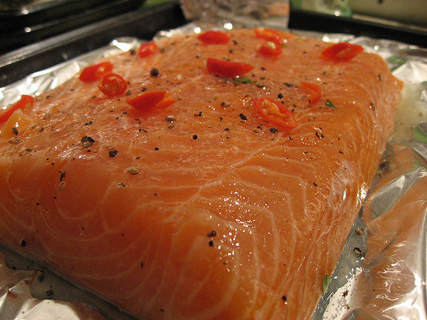Ok, let’s talk about fat. This topic, whoa man. Things are changing. We are coming out of three decades of being told that fat is bad for you. We were told that eating fat will make you fat, and give you heart disease. And as a result of this, food companies came up with hundreds of fat-free products. They took unsaturated fats and hydrogenated them to make them solid like saturated fats. Margarine was born. And around the same time, obesity rates, diabetes, and other chronic illnesses began to rise. Which, in part, is why many doctors and nutritionist are taking another look at fats. Because the logic should’ve followed that if we reduced fat in our diets, than heart disease and obesity rates should decline. However, they have risen. And we are starting to understand much more about the science of nutrition, specifically what happens to fat in the body.
Because fat has been such a scapegoat in our culture, it can be difficult to discuss this topic with open neutrality. Anyone who fears heart disease, or gaining weight will especially be resistant to what is becoming known now about fats. That is, that fat is pretty good for you. And if the right kinds of fats are consumed within the context of a nutrient rich and healthy diet, than many of the health risks we fear (such as obesity, diabetes, heart disease) can actually decline! Even TIME magazine has caught up to the research that is breaking down the myths that fats and cholesterol are bad for you. Breaking down what a fat is, can help us return to a more neutral perspective on fat, rather than looking through a lens of good and bad. Ok, put your science hats on. Chemically, fats are comprised of one acid molecule (glycerol) and three carbon and hydrogen chains. Imagine the letter “E”, where the glycerol is the vertical line and the three horizontal lines are the chains. Those chains are referred to as fatty acids. Now, the chains are important because that is how we can tell if a fat is saturated or unsaturated. Basically, the carbons are bonded to other carbons in a long chain. Since carbons have four covalent bonds, then there are two bonds left which is where the hydrogen come in. Now if you can imagine carbons bonded to each other with hydrogen molecules bonded on the top and bottom of those carbons, that is what we would call a saturated fat. It is simply saturated in hydrogens. This creates a denser substance, which is why saturated fats are more solid at room temperature. These include butter, lard, tallow and coconut oil. Saturated fats have been very demonized by our culture, but new research indicates that saturated fats have health benefits. Medium chain triglycerides (found in coconut oil, a saturated fat) have been shown to slow and in some cases reverse the effects of cognitive decline in Alzheimer’s patients. Our brains are particularly happy to use medium chain triglycerides (MCTs) as a source of optimal fuel. In addition, essential, fat soluble vitamins, like vitamin D and vitamin A are found in saturated fats such as lard, egg yolks, butter and cream. Now, if any of those carbons have a double bond to each other, than that results in a space left open where a hydrogen could’ve been, since two bonds were used between carbons, rather than one. The result is a chain with less saturation of hydrogen, or rather, an unsaturated fat. These fats are typically thinner or less dense, and therefore liquid at room temperature. These include fats, like olive oil or fish oil. Where those double bonds occur on the fatty acid chain also indicates if a fatty acid is an omega-3, omega-6, or omega-9 fatty acid. Both omega-3 and omega-6 are considered essential fatty acids (EFAs) because we need them and must get them from a food source. Our intake of omega-3 EFAs needs to be higher than our intake of omega-6 EFAs, around a 1:1 ratio. It is estimated that our standard American diet puts that ratio way out of balance, with omega-6 fats leading 25:1. Basically this results in too much free radicals, called oxidative stress, which leads to chronic inflammation, which leads to chronic illnesses, such as autoimmunity, and brain related disorders. OK, remember how we mentioned that in the 80’s unsaturated fats were hydrogenated to act more like a saturated fat? These are what we call trans fats. Actually this experimentation began back in the early 1900’s, but became highly promoted in the 80’s during the low-fat and fat-free craze. Trans fats are unsaturated fats that have been blasted with hydrogen molecules to make them act like butter or lard. Possibly a brilliant idea, but trans fats have proven to be so unhealthy that in 2015 the Food and Drug Administration has finally issued a ban on trans fats and all companies need to remove trans fats from their products by 2018. Until then it is very wise to avoid eating anything that says partially hydrogenated or hydrogenated oils. The body is actually very efficient at using fats for fuel. Fats are broken down into ketones by the liver and the brain is able to use those ketones for fuel. Our brains are about 60% fat, and fat is essential for the myelination and communication of our neurons (brain cells). Not only that, but cholesterol, for example, is a building block for our hormones and brain health. And we all know that balanced and healthy hormones are a beautiful thing (think healthy skin and hair, normal blood sugar and weight, fertility, strong libido, energy throughout the day, ability to deal with stress, and so on). So, it’s time to change our mindset about fat and consider incorporating more healthy fats into our diets. Additionally, just adding more fat isn’t going to make you healthier. Check out this article on the best healthy fats to include. And, while you are including more healthy fats, go ahead and limit all that sugar laden, processed, packaged, and refined food. Increasing healthy choices only works if we are decreasing all the unhealthy stuff too! So enjoy some delicious grass-fed butter, coconut oil, or olive oil. Just use it to cook up with some nutrient rich vegetables!
0 Comments
The unfortunate consequence of fat phobia is that we have deprived our bodies of an essential nutrient that is critical for brain and hormone health. This malnourishment has contributed to a large collection of illnesses and compromised brain function. There is a lot to get over, in terms of mindset, around fat, but I encourage you to experiment and begin incorporating more healthy fats into your diet. Look forward to the following positive results from eating more healthy fats.
Ok, so ready to incorporate more fat into your diet? Get started by focusing on these healthy and optimal sources:
In addition to these top seven healthy fats, consider enjoying whole nuts and seeds as well. Eating whole nuts and seeds, that have been cleaned and soaked are a good source of fat and protein, plus fiber and other nutrients (like selenium in brazil nuts). Many people cannot tolerate nuts and seeds, which is why they didn’t make the top seven list here, but if you can, enjoy adding nuts into your diet as well. I recommend soaking them overnight so they are easier to digest and rotating nuts so you aren’t eating the same ones every day. If you’ve been following a low-fat or fat-free diet, then I hope you will consider making some changes. Fat is such an important and vital nutrient for our overall health and can make a drastic difference towards feeling great when we start incorporating more into our diets. And I get that this is a big topic to unravel. If you want more science, check out this article that breaks down the chemical structure of fats. |
Archives
July 2018
Categories
All
|



 RSS Feed
RSS Feed